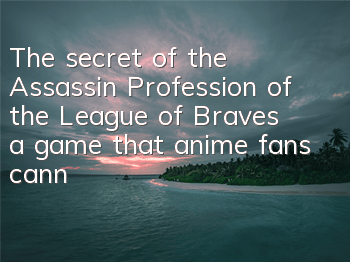Assassin's Creed: Renaissance
Assassin's Creed: Renaissance" Introduction: In Renaissance Italy, subtle political problems were always solved by poison, assassination, and frame-up. Against this background, a mysterious assassin organization is secretly relying on the power of major nobles to grow stronger, and the Medici family, regarded as the "pioneer and strong supporter of the Renaissance", and the literary and artistic master Leonardo da Vinci, have a close connection with this assassin organization.
Medici Family Emblem
The Medici family is famous for sponsoring Italian artists, including Renaissance artists such as Leonardo da Vinci and Michelangelo. But Medici's real purpose in sponsoring art works:
1. Go up the capital market for art and launder money for your large amount of war wealth;
2. Cover the secrets and sins of family capital through the praise and embellishment of the artist.
The history of the Medici family's success is the prototype of the modern Fortune 500 companies in the West.
1. The background of the rise
In 1453, the Ottoman monarch Mohammed II captured Constantinople.
In 1480, Mohammed II attacked Italy, causing great panic.
The Mediterranean, the center of wealth in Europe, fell into the hands of the Ottoman Empire.
However, Ottoman Muslims traditionally prohibit Ottoman bureaucrats from doing business, and even prohibit them from engaging in financial businesses such as mortgages and mortgages. In this way, agents of the Ottoman financial industry, especially financial Jews and Christians, came into being.
At the same time, the Ottoman Empire blocked the market in the Mediterranean. However, smuggling trade is rampant. European princes and nobles, including the Roman Catholic Church, had various agents who privately engaged in smuggling trade with the Ottoman Empire.
2. Make a fortune
The original meaning of the name Medici is a doctor, and the family ancestors were converted to the Jews. Therefore, the ancestors made a living by their financial banking career.
Under the support of the Ottoman Empire, the three generations of heads of the Medici family: Cosimo, Piero and Lorenzo, became the puppet regime of Puyi, and became the comprador of the Ottoman Empire's economic interests in the Mediterranean, managing world-class wealth for the Ottoman Empire.
Cosimo de Medici
Lorenzo Medici
In the 15th century, the Medici family became the richest man in the world.
The success or failure of a red-topped businessman completely maintains the team in the struggle against politics.
Family founder Giovanni Dibic de Medici
The Medici family bank was generally believed to be founded in 1397, and its founder was Giovann of Medici.i di Bicci de' Medici).
The ancestors of the Medici family were converted to the Jews and had a low status. Giovanni's father's distant relative, Vieri di Cambio, was a big money shop owner in Florence and mainly saved the financial income of the Roman church. Giovanni's father started as an apprentice in the money shop and continued to be a partner.
After Giovanni's father's death, Giovanni's son inherited his father's business and worked diligently. In 1385, he became the account manager of the Roman semicolon.
The turning point of fate is that the Gambio Money House is divided into three. At that time, the three giants of Florence's money house were:
Acciaioli family;
Bardi family (Bardi);
Peruzzi family.
The three giants all went bankrupt during the Black Death period in Europe (1348), and the venue was occupied by another large bank Alberti family, and the Alberti family had another internal strife. In 1382, the Alberti clan forces were all expelled from the Florence currency market.
In this way, a vacuum appears in the money market, and Medici money market takes advantage of the situation.
At this time, Medici fully foresaw the great opportunities in Florence in the future. That was the occupation of Pisa in 1406 by Florence, opening up Florence’s only trading port to the Mediterranean, and in 1453 by Mohammed II, the capture of Constantinople, which Florence became the only trading port in the Mediterranean.
The times created opportunities, and Giovanni and Benedetto di Lippaccio de' Bardi of the Buddy family jointly controlled one of Gambio's money houses. Giovanni's task is mainly to do the yin and yang account (libri segreti), the internal account book is kept by the partners and is not external.
On March 26, 1397, Giovanni set up his own money house and moved his business from Rome to Florence. The money bank issues its own currency: Florin coins. The money house lasted until March 24, 1451.
According to the Christian regulations prohibiting resumption, the money house that operates church business only deposits and does not lend. In this way, the Medici Money House accumulated a large amount of capital, and in Florence it could get rid of the financial supervision of the Roman church.
3. Road to becoming rich
Medici began to make a fortune.
On March 25, 1402, Medici opened a third semicolon in Venice.
The gold and silver exchanges in the money shop often require bodyguards to escort them. The crusad monks and mercenaries became the main force of bodyguards. Large-scale money houses often have their own escort agencies. The escort agencies are also set up similar to those of the Crusaders (CoThe concept of mpany, escort agency, escort silver also adopts a partnership with the monk guarding the flag, written as & Co. and other forms.
Crusader Corps
For example, the Strozzi family, the Medici's main competitor, opened the Filippo Strozzi and Co. in Naples, and the Piero del Fede and Co. in Valencia.
Palace of Strozzi
Before the arrival of the Ottoman Empire, the Medici mainly engaged in partnership with senior government officials and married officials and businessmen, and operated court business as the imperial merchant, namely silk, cloth and jewelry.
For example, the Medici family established a partnership bank in Ancona, which was clearly intended to fund Francesco Sforza, the political family of Sforza.
The military or politicians invest in dry or dark shares. This form of partnership is now called limited liability partnership.
In 1446, Medici Money House set up semicolons in Bruges, Belgium and Avignon, France, and soon set up several silver numbers in Lyon.
3. Resign to the Ottoman Empire
Because of the long-term war and political turmoil in the Balkans, sometimes the political team did not have time to stand up, and the business backers collapsed and lost political protection. The limited liability partnership often became an unlimited liability partnership, and the family business immediately declared bankruptcy. Therefore, Italian royal family business rarely exceeds two generations.
In 1453, Mohammed II captured Constantinople, and the Medici family surrendered and was soon designated as a colonial comprador by the Ottoman regime.
Mohamed II conquered Constantinople
What's even more amazing is that the Ottoman Empire blocked the Mediterranean market. However, smuggling trade is rampant. European princes and nobles, including the Roman Catholic Church, had various agents who privately engaged in smuggling trade with the Ottoman Empire.
Due to Pisa and Florence's only trading port in the Mediterranean, the Medici family's forces became invincible overnight.
Around the year when Constantinople was conquered, with the support of the Sforza political family, the Milan semicolon was established, mainly to provide loans to the Sforza court and sell jewelry to the royal nobles.
IV. Investment War
Medici faces extortion from more competitors and more politicians due to the comprador status of the pseudo-regime. Of course, these politicians did not intend to repay. The Medici family mainly gave loans to kings and princes. Kings and princes were war dealers, and the loans were mainly used for war, and the conclusion of the war situationIf it is unpredictable, war is prone to owing huge debts and easily lead to the collapse of the regime. If so, loans will become eternal bad debts.
In 1478, before Duke Sfoza died, he could not repay the Medici 17.9 Wandakot gold coins.
Of course, one of the biggest secrets of the Medici family making a fortune is also an investment war. High returns and high risks coexist. For a war, the Medici family only cares about who wins and who loses. More importantly, the war loan can be recovered.
The War of the Roses was a war between the Yorkists and the rebel Lancashires of the Wang family. Medici lends to both hostile parties.
As a result, loans on both ends became bad debts, and Edward IV, the usurper of the York faction, was even more a deadbeat. Edward IV said that at most, all tariffs were cancelled when the Medici family imported wool to England.
Edward IV
In 1467, when the accountant went to England to collect the accounts, the King of England owed more than 10,000 pounds, the English nobles owed one thousand, and there were still seven thousand payments for the goods not recovered.
Medici knew the risks of these war dealers, but they had to borrow money. England implements the industrial, commercial and food official system. Foreign business names must hold a foreign trade license issued by the imperial court before they can enter the English market. Medici borrows a lot in this area, and the economic costs that must be paid to obtain greater benefits.
In 1478, the Medici London semicolon was closed for liquidation, with all losses reaching 51,000 florin. The later successor, the Tudor Dynasty, had no intention of paying back the debts of its predecessor, the Porcelain Dynasty, and these debts were never paid off.
After the bankruptcy of the London semicolon, its debts are borne by the Bruges semicolon.
5. The wall is falling and everyone pushes it.
The Salviati family of the Pope Silver Florence semicolon was a long-term competitor to the Medici banking family, while Pope Sixt IV (1414 - 1484) was the political enemy of the Medici family.
The Sistine Chapel named after Pope Sixter IV
The Pazzi family, a famous Tuscan political and business family, had no intention of becoming enemies with the Medici family at first. But the Pope authorized the Francis of the Pachy family to monopolize the local alum mines, which are an important raw material for textile dyes, and textile trade is the center of Florence's economy. What is even more tempting is that the Pope authorized Pachy Bank to manage the Pope's fiscal revenue.
Pachy Family Emblem
In addition, the Pope appointed his nephew Girolamo Riario as the lord of Imola and Francis of the Saviardi family as the archbishop of Pisa.
In this way, Francis of the Patch family, Francis of the Saviadi family andThe three of the pope's nephews conspired to murder Lorenzo and Giuliano de' Medici, the head of the Medici family, and sought the support of Pope Sixter IV.
The Pope's wording was cautious, and he said that the Pope's sacred office would not allow him to approve the murder. But he made it clear that whoever could get rid of the Medici family's political status in Florence would be very kind to the Pope, and the relevant personnel would be treated well, and he was willing to provide all support.
On May 26, 1478, ten thousand people attended the solemn Mass at the Cathedral of Florence.
With the acquiescence of the pope, the miscellaneous general Federico da Montefeltro led 600 hiring knives and axemen and lie outside the church.
Assassin's Creed 2 Mission Protects Lorenzo
At the climax of the Mass, Montefitro gave the order, the swordsman entered the church and rushed towards the Medici family.
In the end, Julian of the Medici family was stabbed 19 times by Francis of the Paqi family, fell to the church floor, died of blood, and Lorenzo was seriously injured and fled.
The coup was quickly suppressed, and the rebels were tortured by mobs. Jacob of Pachy's house was stripped naked and paraded in the streets, then drowned after jumping into the river. The Patch family's corporate assets across Europe were divided up. Saviadi was hanged. Most of the coup personnel were executed.
However, after the overthrow of the Medici family in 1494, the exiled Pachi family made a comeback and formed a coalition regime of exile forces.
After the war between Venice and the Ottoman Empire, after Cosimo's death, a large number of Florence enterprises and silver companies went bankrupt.
After the bank was dissolved, Portinari, the head of the bank, had no choice but to serve as a mediator between the war-torn countries in Europe in order to avoid being imprisoned in the debtor's prison when he returned to Florence. After Botinari's death, his descendants refused to inherit the family's inheritance in order to avoid huge debts.
The reason for the decline of Medici Money House is also very simple. First of all, the war situation was uncertain, the princes and nobles who were funded lost power, and the banking system changed from limited liability to unlimited liability. As a result, all the debts were borne by the Medici family, and secondly, the management personnel inside and outside the family made false accounts and were corrupt.
Medici Family Architecture
Summarize the century-old industry of the Medici family, and its main business operations are as follows:
Medici family industry is divided into three major business units:
Silk full industrial chain enterprise group;
Business Groups in the Whole Industry Chain of Cloth;
The entire financial industry chain enterprise group.
The entire Medici family business group covers raw material supply, manufacturing, product design, and raw material procurement, warehousing, transportation, order processing, wholesale, export and terminal sales.
Simply put, under the authorization of colonial agency in the Ottoman Empire, the Medici family gained the power of state capitalism and became the prototype of the modern Fortune 500 enterprises.
For example, Medici monopolized alum mines in Italy, and alum is an important source of textile dyes; Medici also has a full industrial chain system from textile machines to foreign trade export rights enterprises; Medici invested in the war and provided financial loans to both parties; Medici also established a financial and foreign trade system across Europe, integrated financial capital and physical enterprises, and managed colonial wealth for the Ottoman Empire.









